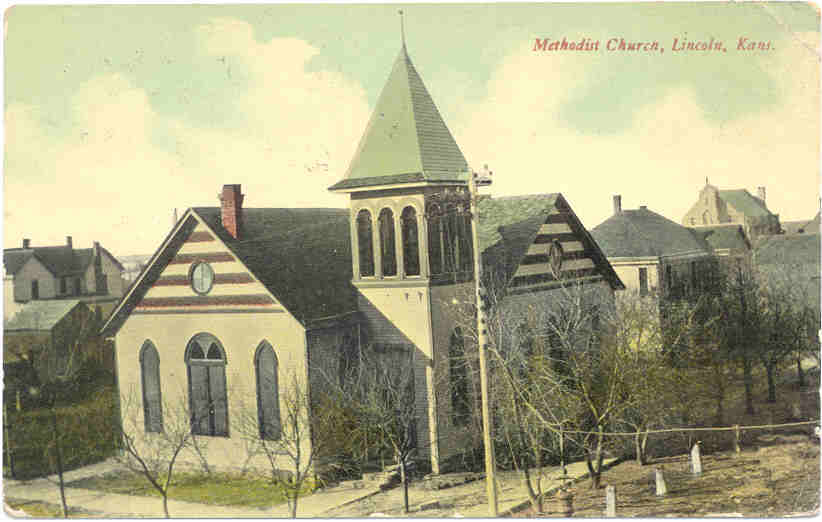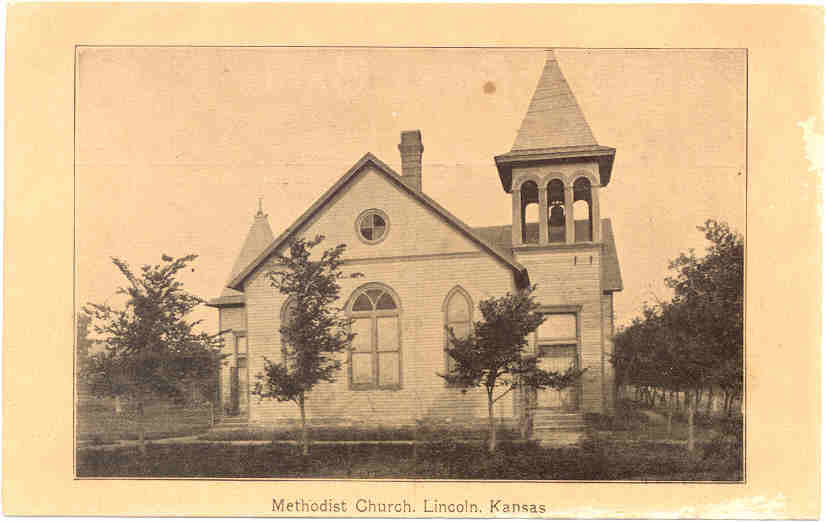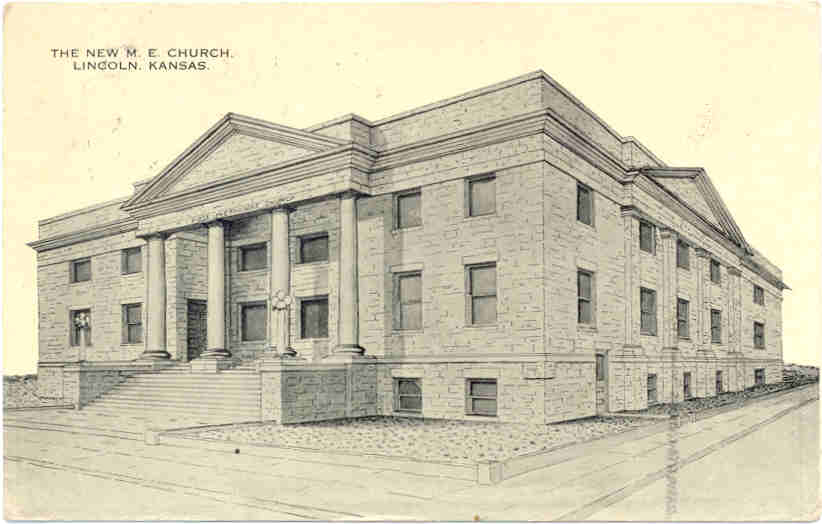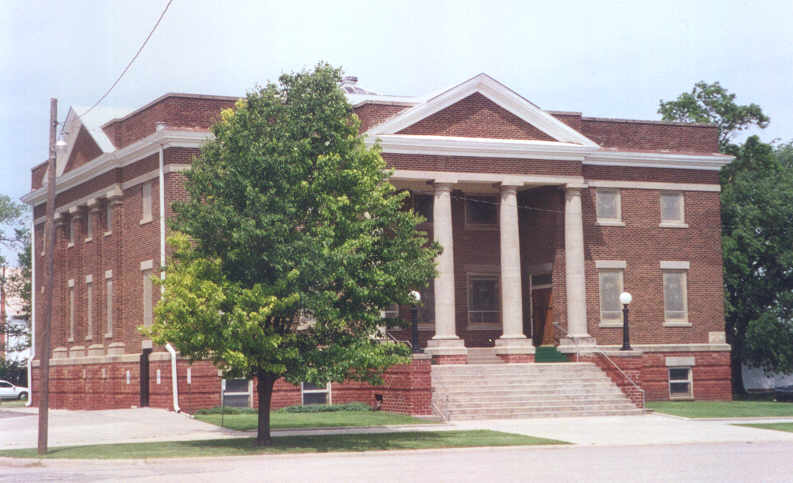Lincoln County Churches
found in the book
HISTORY OF METHODISM IN NORTHWEST KANSAS
by William Henry Sweet
(Salina, Kan. : Kansas Wesleyan University, 1920)
 BARNARD
BARNARDThis name appears first in the list of conference appointments in 1888. The first pastor was G. P. Miller who served the charge two years. At the close of the first year he reported a church worth $740, 75 full members and 35 probationers, a Sunday school having 8 officers and teachers and 100 scholars. In '90 there were two schools with 20 officers and teachers and 100 scholars. But the charge did not grow. In '92 it had gone back to one school with about the original attendance.
The following pastors served the charge: '90-91. J. H. Kuhn, '92, L. E. Baldwin; '93-94, A. Richardson; '95-96, H. R. Goulden; '97-98, D. R. Laport; '99-1900, M. L. Kerr; '01, J. N. See; '02-05, H. W. Wolf; '06, J. A. Schooley; '07, H. W. Wolf; '08, C. W. Muir; '10, B. C. McDonald; '11-13, G. Johnson; '14, B. D. Brooks; '15, F. Gunson; '16-17, O. E. Schall.
The charge showed little sign of growth till near the close of the century. The report of 1899 gives one church valued at $800 and a parsonage worth $200. With the opening of the new century there was indications of new life. In 1901 two churches were reported, which were valued at $2,200; and $1,520 were raised and paid that year. In 1906 a third church was reported, valued at $2,300 and in 1909 the parsonage had been improved by the expenditure of $810. The next year Barnard was reported as a station, there being but one church and it was improved by the expenditure of $1,500. But in 1911 a second church was reported, the two being valued at $3,000. In 1912 the value was placed at $4,000.
The membership has fluctuated in numbers between 70 in 1889 and 180 in 1914. Statistics for 1917 give the following figures: Two churches, $6,000; parsonage, $2,000; membership, 125; preparatory, 12; expenses, $125; pastor, $1,000; district superintendent, $68; bishops, $16; conference claimants, $34; foreign missions, $20; home missions, $15; grand total, $475; Sunday school officers and teachers, 16; enrollments, 273; average, 90; expenses, $120; Epworth League, Sr., 40; Women's Foreign Mission, $11; Women's Home Mission, $7
During the winter of 1874-75, Rev. I. McDowell conducted several revival meetings in different school houses in the vicinity of what is now the neighborhood of Beverly. These meetings were very successful, resulting in securing many converts. One hundred joined at the three points, viz: Madison, Colorado and no. 15 school house. These were attached to Lincoln Circuit.
Vesper and Sylvan Grove were two other points on the circuit. However, this arrangement only continued for a short time. The last two points were attached to Tescott and the Lincoln circuit lay west of Beverly.
In 1887 the town of Beverly was started and the several classes united to form one class at the village. Services were held in the school house, then in the Baptist church, later in a town hall owned by Mr. Staats.
For a number of years, Tescott and Beverly were conjoined to constitute a charge. When thus conjoined, Beverly was at a disadvantage. Tescott having a good large church, was regarded as the head of the charge. In 1898 lots were secured at Beverly on Main street, and a church was built during the pastorate of M. J. Mumford. It was not reported to the Conference till 1901. It was then given a valuation of $2,000.
Until recently there has been no parsonage and consequently the pastor has not resided on the charge. It has been served much of the time by students from the Kansas Wesleyan. In 1916 the church was moved to a more desirable location and a $2,000 parsonage erected adjoining it. The church and parsonage are valued at $4,500. They raised last year for church property, $1,850.
The following are the names of some of the people who were members of the church in the seventies and eighties: Dora Webb, James Bell, Fred Skinner, Tom Skinner, Mr. Lacy, George Ingham, George Hill, John Bell, John Polley, Nathan Eddy, L. S. Ruggles, John Savan, William Ricord, John Shaver, Ive Judd, Charles Cullum, Bill Crosby.
[compiler's note... The binding is very close on this page and some of the text is illegible]
Some of the pastors who have served the church were Isaiah McDowell, S. A. Green, J. W. Blurton(?), John Medcraft, Charles Robinson, J. M. Miller, D,(?) Gurk, J. H. Kuhn, and J. A. Plantz.
January 8, 1913, Plantz reported to the C---? that the pastor had received a donation of $7.00 and a study chair and two boxes of groceries.
The church is now well organized and doing successful work. The membership is 85 and 5 probationers. The Sunday school has a total enrollment of --?, average attendance, 70. The Ladies' Aid is well attended, as is a good Gospel team and a live class of Camp Fire Girls.
The officers are: F. N. Stelson, pastor; Dr. C.(?) Wolfe, president Board of Trustees; Mrs. H. Page(?), president Ladies' Aid; J. H. Horry, superintendent Sunday school; Mrs. Maud Cassell, president, Epworth League; Marie Sperry, president Jr. League; --? Albert Cassel, captain Gospel Team. Stewards are Mrs. Jennie Bell, Miss Lillian Shaver.
Statistics for 1917: Church, $2,000; parsonage, $2,000; full members, 125; preparatory, 5; current expenses, $150; salaries, pastor, $742; district superintendent, $51; bishop, $73; C.C.;s, $26.
Benevolences: Foreign missions, $40; home missions, $40; grand total, $136; Sunday school officials and teachers, 17; enrollment, 125; average, 65; expenses, $70; Epworth League, 40; Junior, 40

December 18, 1870, F. A. Matthews read one of Bishop Morris's sermons to a congregation of 28 people in his own house. This was the first Methodist service held in the vicinity where Lincoln was afterwards built. Matthews continued to read sermons on the Sabbath, most of the time until April following. On January 16, 1871, J. N. Bartels of Salina preached the first Methodist sermon in the county in the Schermerhorn store on the Elkhorn. About forty people were present. On January 22, Matthews and his wife attended a Quarterly meeting at Salina. As there was no organized class any nearer Lincoln, they united with the church at Salina.
In March, 1871, J. N. Bartels was appointed to the Salina Circuit which included Salina, McPherson, Lincoln and Ellsworth counties. The pastor preached his first sermon as preacher in charge, on Sunday, April 2, at the house of Herman Kingsley. In the afternoon of the same day he preached at the Abram town site where he organized the first Methodist class of 13 members. T. A. Matthews was appointed leader and J. C. Parker was chosen steward. On the same day a Sunday school was organized with T. A. Matthews as superintendent. April 16, J. Medcraft, who had just moved into the neighborhood, preached in the store at Abram. March 7, John Connor, who had been appointed junior preacher on the charge preached at the new store and at Schermerhorn's. May 14, Bartells [sic!] preached the funeral of Walter Buzick in the Schermerhorn barn.
The first sacramental service was held in the store at Abram's, July 23, 1871, J. Boynton, of Salina, officiating. Medcraft and Matthews held services on alternate Sabbath's until October. The minutes for the Quarterly Conference for this first year of the Lincoln charge are in the hands of the keeper of the records. This is highly commendable and is quite in contrast with thecondition of records in most charges. The Quarterly Conferences were held as follows: First at Monroe school house, June 22, 1872; second, at Valley school house, September 18, 1872; third, at the house of T. A. Matthews, December 4, 1872, and the fourth at Monroe school house, March 8, 1873. The report of the pastors' salary at each of the Quarterly Conference was as follows: $5.00 reported at the first, nothing at the second, $87.90 at the third and $121.65 at the fourth. Total, $214.55. The general rules had been read each quarter except at two appointments.
In 1890 there was a large revival resulting in 48 additions to the church. In January, 1912, twenty-six members united with the church and the Sunday school had grown to such an extent that an additional building had been constructed for the primary department. The enrollment of the Sunday school in 1912 was 450 with an average attendance of 361.
The first church in Lincoln was built in 1885, W. T. Robinson being pastor. In a few years a larger was erected on the same site. For the building of this a loan was obtained from the Building and Loan Association. In 1900 during the pastorate of A. J. Schermerhorn, the church was again rebuilt. While C. W. Stevens was pastor the room was built for the primary department which was mentioned above. In 1913 Stevens was appointed to the Ellsworth District and G. R. Hall was sent to Lincoln as pastor. The Sunday School continued to grow. During Hall's third year a modern brick church was planned and on the 13th of December, 1915, the corner stone was laid. At the Conference of 1916, Hall was appointed to the Salina District and J. R. Thomas was appointed to Lincoln. The church was completed and was dedicated September 10, 1916. The cost was $26,000. $9,000 was needed on dedication day to clear the building of debt. J. F. Harmon, President of Kansas Wesleyan University, was in charge of the service and in a short time $11,000 was pledged and the building was dedicated to the services of Almighty God.
Statistics for the year 1917; Church, $26,500; parsonage, $3,000; current expenses, $300; pastor's salary, $1,800; district superintendent, $120; bishop, $30; conference claimants, $75; membership, 345; probationers, 24; Sunday school, 487; officers and teachers, 41
 Another
view of the Methodist Church mentioned above. This photo was taken in 1900,
shortly after the church had been remodeled. A choir loft and belfry had been
added and other improvements, such as stained glass windows, were made, at a
cost of $1,500.
Another
view of the Methodist Church mentioned above. This photo was taken in 1900,
shortly after the church had been remodeled. A choir loft and belfry had been
added and other improvements, such as stained glass windows, were made, at a
cost of $1,500.
 LINCOLN
METHODIST
LINCOLN
METHODIST
A drawing of the current Methodist Church, which was
completed in 1916. The church stands at the corner of Fourth and School streets
in Lincoln.
 LINCOLN
METHODIST
LINCOLN
METHODIST
The Methodist Church as it looks today, in a photo taken in
May 2004.
It was in 1888 that the name Sylvan Grove first appears among the list of appointments, supplied by H. F. Odell. Nothing is known as to other points were connected with it to constitute a circuit, except that they were lacated in Lincoln, Ellsworth, Russell, and Osborne counties. The next year, 1889, Sylvan Grove and Lucas were served by L. A. Dugger who remained on the charge during '90 and '91. J. W. Blundon was the pastor in '92; A. C. Frick supplied in '93 and George Nulton was appointed in '94. Following him were A. T. Mitchell, '95-97; W. O. Woolever, '98. Woolever was reappointed in '99 but remained only a short time and H. F. Tole, a student at Kansas Wesleyan supplied the rest of the year; 1900, A. N. See; 1901, L. A. McKeever. In September McKeever was relieved to attend school and E. P. Raby was appointed and served the charge until the Conference of 1904. 1904, J. O. Barton; '05, George Graham supplied until September when M. R. Starbuck was appointed and he remained with the charge until 1910. C. A. Sullivan, '10-11; James Kerr, '12-13; J. A. Templin, '14-15; W. E. Scott, '16; V. V. Whitsit, '17.
The church was built in 1892 during the pastorate of J. W. Blundon on lots donated by H. S. Busick [sic!]. In 1900 Lucas became a separte charge and Sylvan and Excelsior constituted the circuit. Revivals from time to time have been conducted on the circuit. In 1891 a special meeting resulted in 17 conversions and 13 accessions to the church.
The church at Excelsior was built in 1901 and the dedicatory sermon preached by M. E. Phillips the president of Kansas Wesleyan University. The cost of the church was $2300.
[compiler's note: Someone has written next to this paragraph: E. O. Harbin (sp?) served while in college in Salina, 1915)
Statistics for 1917: Church, $2500; parsonage, $1200; members, 66; with 4 preparatory; pastor's salary, $1100; Dist. Sup., $68; bishop, $17; benevolences, $481; Sunday Schools, 2; enrollment, 184; Ep. League, 20; Junior League, 25; W. F. M. S., $8; W. H. M. S., $49